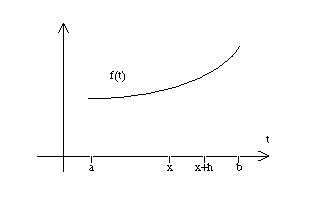
The purpose of this project is to explore the problem of computing the derivative of a function defined by an integral. For the first part of the project, we begin with two fixed numbers a < b and a function f(t) that is continuous and nonnegative on the interval [a,b]. For every x such that a <= x <= b, we define a function F(x) by the integral of f(t) from t=a to t=x.
Notice that for fixed x, this integral is a number; hence, with x as a variable, the integral defines a function of x. We will postpone making specific choices for the function f and the constant a for now. (The choice of b is not important as long as f is continuous and nonnegative on [a,b] and b is larger that nay desired x.)
The first part of the project considers functions such as F(x). In particular, the goal is to derive a formula for the derivative of such a function F(x). Begin by drawing (on a separate page) two graphs like the one below:

[1] Both F(x+h) and F(x) can be interpreted as areas of certain regions. Describe in words what these regions are and sketch them on your first graph.
[2] The quantity F(x+h)-F(x) can also be interpreted as an area of a region. Describe this region in words. Also draw and shade in this region on your second graph.
[3] The area of the region in [2] can be approximated by the area of a simple rectangle whose height does not depend on h. Describe the rectangle and draw it on your second graph.
[4] From the definition of F(x) as an integral, one can see that (F(x+h)-F(x))/h is (1/h) times the integral of f(t) from t=x to t=x+h. Does the quantity (F(x+h)-F(x))/h represent an area or a length? Indicate this quantity on your second graph.
[5] What happens as h gets smaller and smaller? Use your observation to determine F'(x) (which by definition is the limit as h approaches 0 of (F(x+h)-F(x))/h.)
The second part of the project involves an application of the result obtained in the first part. For the questions below, take a=0 and f(t)=exp(-t^2/2)/(2PI)^(1/2), where PI=3.1415... . The resulting function F(x), i.e., the integral of the given f(t) from 0 to x, is very important in statistics and in mathematical models of heat conduction.
[6] Estimate the value of F(x) at x=1 and at x=1.001. Indicate how you obtained these estimates. Also find the average rate of change of F(x) over the interval x=1 to x=1.001.
[7] Use the results from [5] to determine the derivative of F(x). In particular, determine F'(1) and compare the result to the average rate of change of F you found in [6].
[8] Let G(x) be the integral of f(t) from t=0 to t=x^2. How is the function G(x) related to the function F(x)? Calculate G'(x). [Hint: Apply the Chain Rule.]
Advice: Write a coherent report that presents your answers to the questions. Your report should be understandable by someone who has not seen the list of questions. Use descriptive section headings rather than question numbers to indicate the topics in your report. Write clearly in English using mathematical notation where needed.